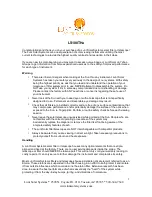
7
sharp, retighten the lock ring behind the objective lens cell. The
finderscope’s focus should not need to be adjusted again.
5. Setting Up and Using
the Equatorial Mount
When you look at the night sky, you no doubt have noticed that
the stars appear to move slowly from east to west over time. That
apparent motion is caused by the Earth’s rotation (from west to
east). An equatorial mount (Figure 5) is designed to compensate
for that motion, allowing you to easily “track” the movement of
astronomical objects, thereby keeping them from drifting out of
the telescope’s field of view while you’re observing.
This is accomplished by slowly rotating the telescope on its right
ascension axis, using only the R.A. slow-motion cable. But first
the R.A. axis of the mount must be aligned with the Earth’s rota-
tional (polar) axis—a process called polar alignment.
Polar Alignment
For Northern Hemisphere observers, approximate polar
alignment is achieved by pointing the mount’s R.A. axis at the
North Star, or Polaris. It lies within 1° of the north celestial
pole (NCP), which is an extension of the Earth’s rotational
axis out into space. Stars in the Northern Hemisphere appear
to revolve around the NCP.
To find Polaris in the sky, look north and locate the pattern of
the Big Dipper (Figure 6). The two stars at the end of the
“bowl” of the Big Dipper point right to Polaris.
Observers in the Southern Hemisphere aren’t so fortunate to
have a bright star so near the south celestial pole (SCP). The
star Sigma Octantis lies about 1° from the SCP, but it is bare-
ly visible with the naked eye (magnitude 5.5).
For general visual observation, an approximate polar align-
ment is sufficient.
1. Level the equatorial mount by adjusting the length of the
three tripod legs.
2. Loosen the latitude lock lever. Turn the latitude adjustment
knob and tilt the mount until the pointer on the latitude scale
is set at the latitude of your observing site. If you don’t know
your latitude, consult a geographical atlas to find it. For
example, if your latitude is 35° North, set the pointer to +35.
Then retighten the latitude lock lever. The latitude setting
should not have to be adjusted again unless you move to a
different viewing location some distance away.
3. Loosen the Dec. lock lever and rotate the telescope optical
tube until it is parallel with the R.A. axis, as it is in Figure1.
Retighten the Dec. lock lever.
4. Lift and rotate the tripod so the telescope tube (and R.A.
axis) points roughly at Polaris. If you cannot see Polaris
directly from your observing site, consult a compass and
rotate the tripod so the telescope points North.
The equatorial mount is now polar-aligned for casual observ-
ing.
More precise polar alignment is required for
astrophotography.
Polar Aligning Using the Polar Axis Finder
One of the unique features of your new SkyView Deluxe
mount is the polar axis finder scope. It fits conveniently inside
the equatorial mount, and contains a tiny star map that makes
precise polar alignment quick and easy. To use the polar axis
finder scope, follow these instructions:
1. Approximately polar-align the mount as outlined in the
procedure above.
2. Remove the caps that cover the polar finder (one on the
polar finder’s eyepiece and one on the front of the equa-
RIG
HT
AS
CE
NS
IO
N
AX
IS
Declination (Dec.)
setting circle
Polar axis finder scope
port (front), with cap
Azimuth
adjustment
knob
Right
ascension
(R.A.)
setting circle
Polar axis
finder scope
Latitude scale
Latitude
adjustment
knob
D
E
C
L
IN
A
T
IO
N
A
X
IS
Figure 6. To find Polaris in the night sky,
look north and find the Big Dipper. Extend
an imaginary line from the two “Pointer
Stars” in the bowl of the Big Dipper. Go
about five times the distance between those
stars and you’ll reach Polaris, which lies
within 1° of the north celestial pole (NCP).
Big Dipper
(in Ursa Major)
Little Dipper
(in Ursa Minor)
N.C.P.
Poin
ter S
tars
Polaris
Cassiopeia
Figure 5. SkyView Deluxe equatorial mount.




















